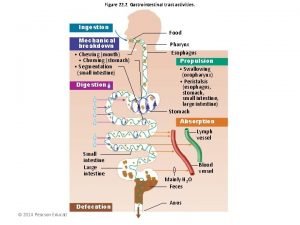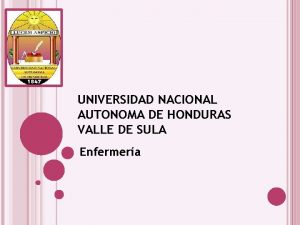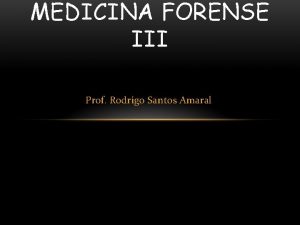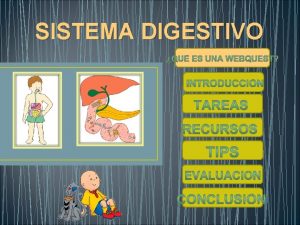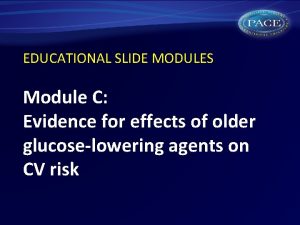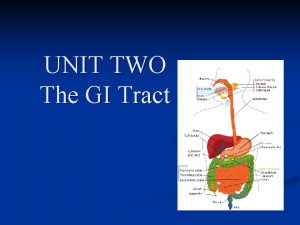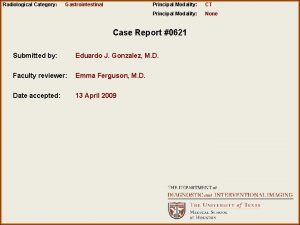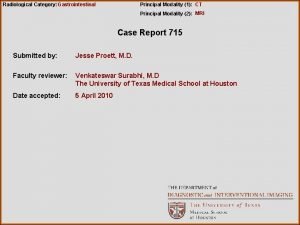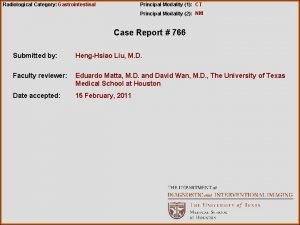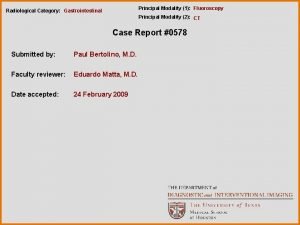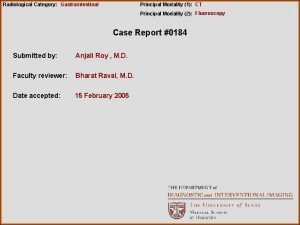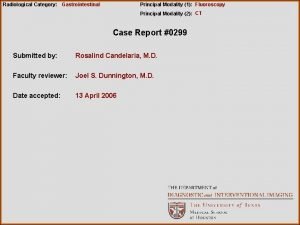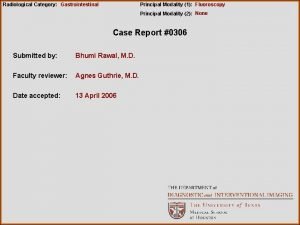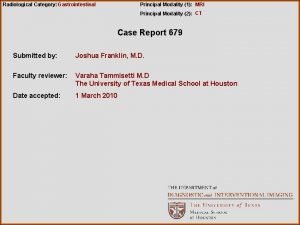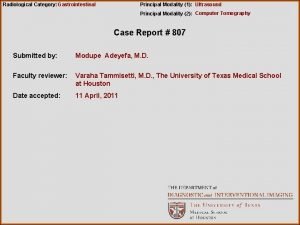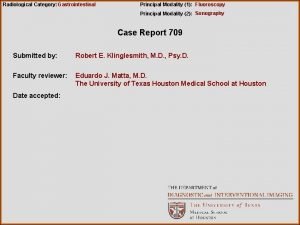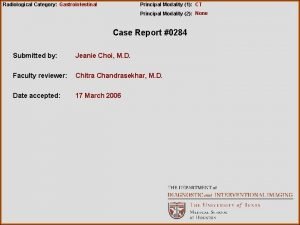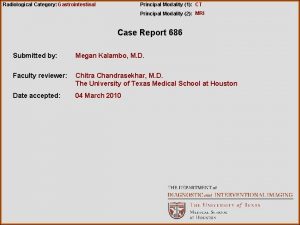Radiological Category Gastrointestinal Principal Modality 1 Principal Modality














- Slides: 14

Radiological Category: Gastrointestinal Principal Modality (1): Principal Modality (2): Case Report #0117 Submitted by: Joy A. Henningsen, M. D. Faculty reviewer: Ronald Bilow, M. D Date accepted: 02 April 04 CT General Radiography

Case History Fifty-nine-year-old male with unknown past medical history complaining of vomiting and severe chest pain. There was no record of him having had any recent procedures at our institution.

Radiological Presentations CT Chest with contrast

Radiological Presentations CT Chest with contrast

Radiological Presentations Esophagram following administration of 50 cc Gastrografin via NGT

Radiological Presentations Esophagram following administration of 50 cc Gastrografin via NGT

Radiological Presentations Esophagram following administration of 50 cc Gastrografin via NGT

Test Your Diagnosis Which one of the following is your choice for the appropriate diagnosis? After your selection, go to next page. • Spontaneous Pneumothorax • Boerhaave’s Syndrome • Aortic Dissection • Mallory-Weiss Syndrome • Esophageal Hematoma

Findings and Differentials CT Findings: --Bilateral pneumothoraces --Pneumomediastinum --Bilateral effusions

Findings and Differentials Barium Swallow Findings: --Contrast extravasation from the distal esophagus into both pleural cavities --The exam was subsequently terminated. Differentials: • Boerhaave’s Syndrome • Foreign Body Perforation of the Esophagus

Discussion Boerhaave’s Syndrome refers to spontaneous esophageal perforation and is secondary to phenomena that increase intraluminal pressure within the esophagus such that all three mucosal layers are disrupted (as opposed to a Mallory-Weiss tear, which only involves the mucosa). The condition is grave secondary to subsequent development of mediastinitis. Other etiologies of esophageal perforation (e. g. iatrogenic, foreign bodies, trauma, labor, forceful vomiting and/or straining) are equally morbid for the same reason. The syndrome is most common in adults (particularly males), in whom the most common location of the tear (90%) is the site least protected from herniation by adjacent structures--that is, the left posterolateral wall of the distal esophagus. In neonates, the syndrome is more common in females and usually involves the right distal esophagus. Clinically, vomiting, severe chest pain, and subcutaneous air in an adult should alert one to the diagnosis, although patients may present without this “textbook” pattern. (Continued on next slide)

Discussion (continued) On a conventional chest radiograph, pneumothorax, pneumomediastinum, mediastinal widening, and subcutaneous air are common findings. A delayed radiograph twelve to twenty-four hours after the inciting event may reveal a left pleural effusion or left pneumothorax (reflecting the fact that most ruptures occur on the left). The Nacleiro sign represents air dissecting from the mediastinum down to the left diaphragmatic pleura and appears as a “V”-shaped lucency. The other primary modality for evaluating Boerhaave’s syndrome is the contrast esophagram. A water-soluble contrast such as gastrografin is the agent of choice initially, because barium is known to cause a severe mediastinitis. However, if the exam is negative and if esophageal rupture is still suspected, barium should be used to confirm the diagnosis as well as to aid the surgeon by delineating the location and length of the perforation. CT, while it may not be as good at identifying the exact site of perforation, rules out other causes of chest pain and/or nausea and vomiting. Management is primarily surgical/interventional (e. g. primary repair, diversion procedures, T-tube drainage, or expanding stents) but also includes antibiotics and supportive measures such as fluid resuscitation.

Discussion (Continued) References: Bjerke, H. Scott. Boerhaav’es Syndrome and Barogenic Injuries of the Esophagus. Chest Surgery Clinics of North America. Vol 4, Number 4, Nov. 1994. pp. 819 -825. Gore, Richard M. and Marc S. Levine. Textbook of Gastrointestinal Radiology. 2 nd Edition, 2000 W. B. Saunders Co. , Philadelphia, pp. 466 -71. Margulis, Alexander R. and H. Joachim Burhenne. Alimentary Tract Radiology. 4 th Edition, 1989 Mosby, St. Louis, p. 455.

Diagnosis Boerhaave’s Syndrome
 Erate category 2
Erate category 2 Tennessee division of radiological health
Tennessee division of radiological health Center for devices and radiological health
Center for devices and radiological health National radiological emergency preparedness conference
National radiological emergency preparedness conference Radiological dispersal device
Radiological dispersal device Gastrointestinal
Gastrointestinal Motilidad gastrointestinal
Motilidad gastrointestinal Emt chapter 18 gastrointestinal and urologic emergencies
Emt chapter 18 gastrointestinal and urologic emergencies Borborygmi
Borborygmi Gastrointestinal disease
Gastrointestinal disease Palpation percussion auscultation
Palpation percussion auscultation Docimasia gastrointestinal
Docimasia gastrointestinal Embriologia del sistema gastrointestinal
Embriologia del sistema gastrointestinal Why does metformin cause diarrhea
Why does metformin cause diarrhea Upper gi bleeding management
Upper gi bleeding management





